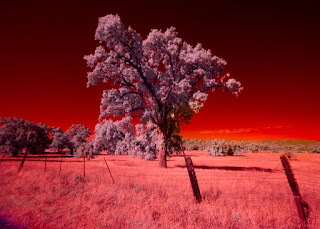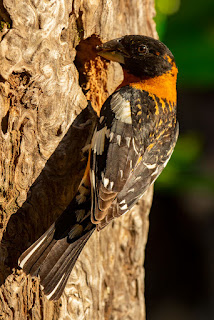Recently I went out during the middle of the day at almost high noon to do some photography. I had a spot in mind that I have photographed many times before. Normally high noon is one of the least desirable times for landscape photography. The light is very bright making images look very flat and uninteresting. For me it was just the perfect way to explore doing some more infrared photography. Once I arrived I started looking at the many possibilities for images. There are some wonderful S curves in the road there for creating leading lines as well as the many beautiful valley oaks that are subjects unto themselves. I found some great images to explore before the midday heat drove me back to the car. All images were created with a Canon EOS 7D camera converted to infrared Hypercolor. I was using a Canon EF- S10-22mm lens with a red filter. God's love and blessings to you, chris #teamcanonusa
This blog is a "Blogs of Note" It was chosen by the Blogger Team at Google as being Interesting and noteworthy. It is a once a week look at what I photograph. Please check out my new book on Amazon. "Secrets of Backyard Bird Photography". It is available in hardbound as well as an ebook. http://www.amazon.com/Secrets-Backyard-Photography-Chris-Hansen/dp/1937538559 It would make a great gift for a birder or photographer that you know or just buy it for yourself!
Tuesday, July 28, 2020
Saturday, July 25, 2020
Branching Off in a New Direction
After a lot of thought my photography is branching off in a new direction. I've always liked exploring and learning new things. Infrared photography has always intrigued me. I suppose because it is often done in B+W which is what I did a lot of during my early years in photography. I loved the darkroom and shooting in B+W both in high school and in college. Which now brings me to the present. They make and convert cameras that shoot in infrared. After a couple of months of off and on research I ordered a Canon EOS 7D that had been converted to Hyper Color Infrared. I was like a little kid in a candy store when it arrived. Photographing the forest in the front yard and driving out to the Little Lake Valley and photographing the large valley oaks. It's crazy what you can do with it. Processing images from this new camera has been challenging. It has stretched my Photoshop skills to a new level with new settings such as channel swapping and and desaturation levels. It's going to be fun to go out to create landscapes and seascapes with it.
God's love and blessings to all, chris
#teamcanonusa All images were created with a Canon EOS 7D camera and a Canon EF-s 10-22mm lens.
God's love and blessings to all, chris
#teamcanonusa All images were created with a Canon EOS 7D camera and a Canon EF-s 10-22mm lens.
Friday, July 17, 2020
Cool Creature of the Night
Last night as I went outside to take in the hummingbird feeder (otherwise the bears and raccoons will get it) I spotted a bright glow on the flagstone of the back patio. Looking closer it seemed to be some sort of segmented worm. I photographed it and the brought it inside to photograph it in the light. Later looked it up and it is called a California Pink Glowworm. But isn't actually a worm at all. It is Microphotus angustus, a genuine firefly beetle. Another strange fact is that only the female larvae glow. They also never turn into an adult form of beetle. They stay in larval form their entire lives. When the males change into an adult beetle. They fly about at night looking for a glowing female to mate with. She then lays her eggs into the leaf litter and goes about looking for slugs and worms to feed on. It was a cool find. God's blessings upon your day, chris
Saturday, July 11, 2020
High Key and Low Key
A couple of days ago I walked past the Gladiolas blooming in the garden and I thought to myself. I 'd really like to photograph them. Early this evening Lenore and I went to harvest some greens for breakfast tomorrow. AsI walked past the glads I noticed that they are already starting to wilt. I knew it was now or never1 I clipped the freshest looking pink one that I could find. Tonight at home I set up a piece of white foamcore with the Gladiola directly in front of it. I placed an AlienBees 1600 Studio light with a small soft box right behind everything. I hand held another Alien Bee 1600 from slightly above and to the right from the front. I tried several exposure settings to get what I was looking for. I uploaded the image and I was blown away by the details of the flower from the light passing through it. then I took Badger the Wonder Dog for a walk. As we walked I thought of a set up to rephotograph the Gladiola on a black background. This time I used a piece of black foamcore with the flower in front of it. I used the same studio lights except I set up the softbox from the right side with a grid to stop any light spilling onto the background. Once again I handheld the other Alien bees light though this time it was from slightly behind and from the left. I was really happy with how the images came out. Both images were created with a Canon EOS 7D MKII camera and a Tamron 28-200mm lens. The camera settings used were M mode, ISO 100, F 5.0 and F 9.0 at 1/160th of a sec. lighting was provided by two Alien Bees 1600 Studio lights. God's blessings upon your weekend, chris
Saturday, July 4, 2020
Knothole Bird Feeder
I set up a knothole bird feeder in the yard to try and capture some close up images of the Black-headed Grosbeaks. I put it right next to my platform bird feeder . Then I cleared out all of the bird seed from the platform feeder forcing them to look for food close by. After settling into the photoblind the birds started coming in. They were looking all over the place until a Steller's Jay discovered the small hole. It looked at it quizzically for a bit and then dove right in grabbing a few seeds and flying off. The jays really got into it. After they left the grosbeaks gave it a try. They were actually easier to photograph because when one of them would land on the feeder they would park themselves and keep feeding for quite awhile. Here are three of my favorite images. God's blessings upon your weekend. To all of you Americans out there, Happy Fourth of July! All of these images were created with a Canon EOS 7D MKII camera and a Canon 100-400IS v.1 lens. #teamcanonusa
Subscribe to:
Posts (Atom)












